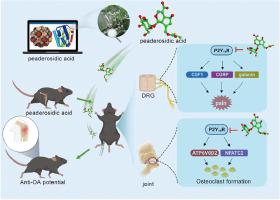Phytomedicine ( IF 6.7 ) Pub Date : 2023-05-02 , DOI: 10.1016/j.phymed.2023.154851 Yuxin Li 1 , Yehong Li 1 , Yifan Zhu 2 , Wen Ji 2 , Yaxuan Wang 2 , Xinli Dong 1 , Xin Zhao 1 , Ting Wang 1 , Sheng Tian 3 , Qinghua Hu 1 , Huanqiu Li 2 , Mengze Zhou 1

|
Background
The activation of P2Y14 receptor (P2Y14R) promotes osteoclast formation and causes neuropathic pain, exhibiting possible link to osteoarthritis (OA). Given lack of P2Y14R antagonist, the present study aims to search a novel P2Y14R antagonist with low toxicity and high activity from natural products as a possible drug candidate in treatment of OA.
Methods
The role of P2Y14R on OA was verified using P2Y14R knockout (KO) rats. Molecular docking virtual screening strategy and activity test in P2Y14R stably-expressed HEK293 cells were used to screen target compound from natural product library. The MM/GBSA free energy calculation/decomposition technique was used to determine the principal interaction mechanism. Next, the binding of target compound to P2Y14R was examined using cellular thermal shift assay and drug affinity responsive target stability test. Finally, the therapeutic effect of target compound was performed in monosodium iodoacetate (MIA)-induced OA mouse model. To verify whether the effect of target compound was attributed to P2Y14R, we establish the osteoarthritis model in P2Y14R KO mice to perform pharmacodynamic evaluation. Importantly, to investigate the potential mechanism by which target compound attenuate OA, expressions of the major transcription factors involved in osteoclast differentiation were detected by western blot, while markers of nerve damage in dorsal root ganglion (DRG) were evaluated by RT-qPCR and immunofluorescence techniques.
Results
Deficiency of P2Y14R alleviated pain behavior and cartilage destruction in MIA-induced OA rats. 14 natural compounds were screened by Glide docking-based virtual screening, among which paederosidic acid exhibited the highest antagonistic activity to P2Y14R with IC50 of 8.287 μM. As a bioactive component extracted from Paederia scandens, paederosidic acid directly interacted with P2Y14R to enhance the thermostability and decrease the protease sensitivity of target protein, which significantly inhibited receptor activator for nuclear factor-κB ligand (RANKL)-mediated osteoclastogenesis. More importantly, paederosidic acid suppressed osteoclast formation by downregulating expressions of NFAT2 and ATP6V0D2, as well as relieved neuropathic pain by decreasing expressions of CGRP, CSF1 and galanin in DRG.
Conclusions
Paederosidic acid targeted P2Y14R to improve OA through alleviating osteoclast formation and neuropathic pain, which provided an available strategy for developing novel drug leads for treatment of OA.
中文翻译:

基于结构的虚拟筛选发现鸡翅根中的 pederosidic acid 作为新型 P2Y14R 拮抗剂
背景
P2Y 14受体 (P2Y 14 R)的激活会促进破骨细胞形成并引起神经性疼痛,这可能与骨关节炎 (OA)相关。鉴于缺乏P2Y 14 R拮抗剂,本研究旨在从天然产物中寻找一种低毒、高活性的新型P2Y 14 R拮抗剂作为治疗OA的可能候选药物。
方法
使用 P2Y 14 R 敲除 (KO) 大鼠验证P2Y 14 R 对 OA的作用。采用P2Y 14 R稳定表达的HEK293细胞分子对接虚拟筛选策略和活性测试,从天然产物库中筛选目标化合物。MM/GBSA 自由能计算/分解技术用于确定主要相互作用机制。接下来,目标化合物与 P2Y 14 R 的结合使用细胞热转移测定和药物亲和力响应目标稳定性测试进行检查。最后,在碘乙酸钠(MIA)诱导的OA小鼠模型中研究了目标化合物的治疗效果。验证目标化合物的作用是否归因于 P2Y 14R,我们建立P2Y 14 R KO小鼠骨关节炎模型进行药效学评价。重要的是,为了研究目标化合物减弱 OA 的潜在机制,通过蛋白质印迹检测了参与破骨细胞分化的主要转录因子的表达,同时通过 RT-qPCR 和免疫荧光评估了背根神经节 (DRG)中的神经损伤标志物技巧。
结果
P2Y 14 R 的缺乏减轻了 MIA 诱导的 OA 大鼠的疼痛行为和软骨破坏。基于Glide对接的虚拟筛选筛选出14种天然化合物,其中paederosidic acid对P2Y 14 R的拮抗活性最高, IC 50为8.287 μM。作为从鸡冠花中提取的生物活性成分,鸡爪苷酸直接与 P2Y 14 R 相互作用以增强热稳定性并降低靶蛋白的蛋白酶敏感性,从而显着抑制核因子-κB 配体 (RANKL) 介导的破骨细胞生成的受体激活剂。更重要的是,paederosidic acid 通过下调 NFAT2 和 ATP6V0D2 的表达来抑制破骨细胞的形成,并通过降低DRG 中CGRP
结论
Paederosidic acid 靶向 P2Y 14 R 以通过减轻破骨细胞形成和神经性疼痛来改善 OA,这为开发用于治疗 OA 的新型药物先导提供了一种可用的策略。











































 京公网安备 11010802027423号
京公网安备 11010802027423号